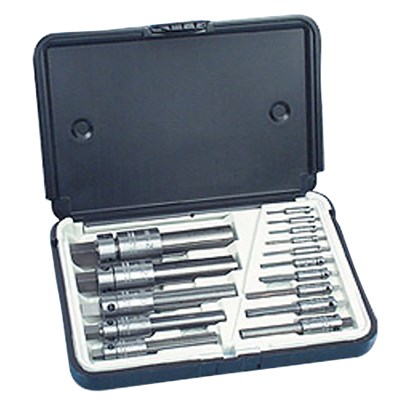

Tapping with fragile taps (smaller ones)ĩ. The material you’re tapping is too hardĥ. If you want to avoid this headache, it may be helpful to know WHY taps commonly break. Whereas the machinist who finds patience and is thorough, could remove that same tap with success. Then they will write off the tool they used like it is the tool’s fault.
#Tap extractor how to
There are many cases where a machinist will be overconfident and go at the tap without reading instructions or researching how to pull off the meticulous act. If you rush the process or pursue a makeshift option, chances are you will worsen the problem. No better place to ask around than the Practical Machinist forum.īut one thing is for sure, and that’s that patience is required. Because this process is so situational, if you find yourself in this situation it will be helpful to grab advice from someone with similar experience. For example using a tap extractor on cast iron is a completely different story than using it on steel.

The metal type combined with how exactly the tap became stuck will determine which method you should use to try to remove it. Unfortunately, there is no one size fits all solution for extracting a tap since many variables are at play. Only enabled by default on iOS because that is the platform standard there.It is not uncommon to bust your taps when threading. Makes section headers stick to the top of the screen until the next one pushes it off. Also receives highlighted,, and any custom props from separators.updateProps. These are intended to separate sections from the headers above and below and typically have the same highlight response as ItemSeparatorComponent. Rendered at the top and bottom of each section (note this is different from ItemSeparatorComponent which is only rendered between items). by 100 pts), use progressViewOffset=) => element | null To offset the RefreshControl from the top (e.g.

Make sure to also set the refreshing prop correctly.

If provided, a standard RefreshControl will be added for "Pull to Refresh" functionality. Rendered at the very beginning of the list. Note that this sets keys for each item, but each overall section still needs its own key. The default extractor checks item.key, then falls back to using the index, like React does. Key is used for caching and as the React key to track item re-ordering. Used to extract a unique key for a given item at the specified index.
#Tap extractor update
renderItem provides separators.highlight/ unhighlight which will update the highlighted prop, but you can also add custom props with separators.updateProps. By default, highlighted, section, and props are provided. Rendered in between each item, but not at the top or bottom. Note these items will never be unmounted as part of the windowed rendering in order to improve perceived performance of scroll-to-top actions. This should be enough to fill the screen but not much more. How many items to render in the initial batch. functions depend on anything outside of the data prop, stick it here and treat it immutably. If any of your renderItem, Header, Footer, etc. TypeĪ marker property for telling the list to re-render (since it implements PureComponent). The actual data to render, akin to the data prop in FlatList. Reference Props VirtualizedList Props Alternatively, you can provide a custom keyExtractor prop. By default, the list looks for a key prop on each item and uses that for the React key.This is a tradeoff that can be adjusted to suit the needs of each application, and we are working on improving it behind the scenes. This means it's possible to scroll faster than the fill rate and momentarily see blank content. In order to constrain memory and enable smooth scrolling, content is rendered asynchronously offscreen.This includes the data prop and parent component state. extraData) that is not = after updates, otherwise your UI may not update on changes. Make sure that everything your renderItem function depends on is passed as a prop (e.g. This is a PureComponent which means that it will not re-render if props remain shallow-equal.Make sure all your data is captured in the item data or external stores like Flux, Redux, or Relay. Internal state is not preserved when content scrolls out of the render window.This is a convenience wrapper around, and thus inherits its props (as well as those of ) that aren't explicitly listed here, along with the following caveats:


 0 kommentar(er)
0 kommentar(er)
